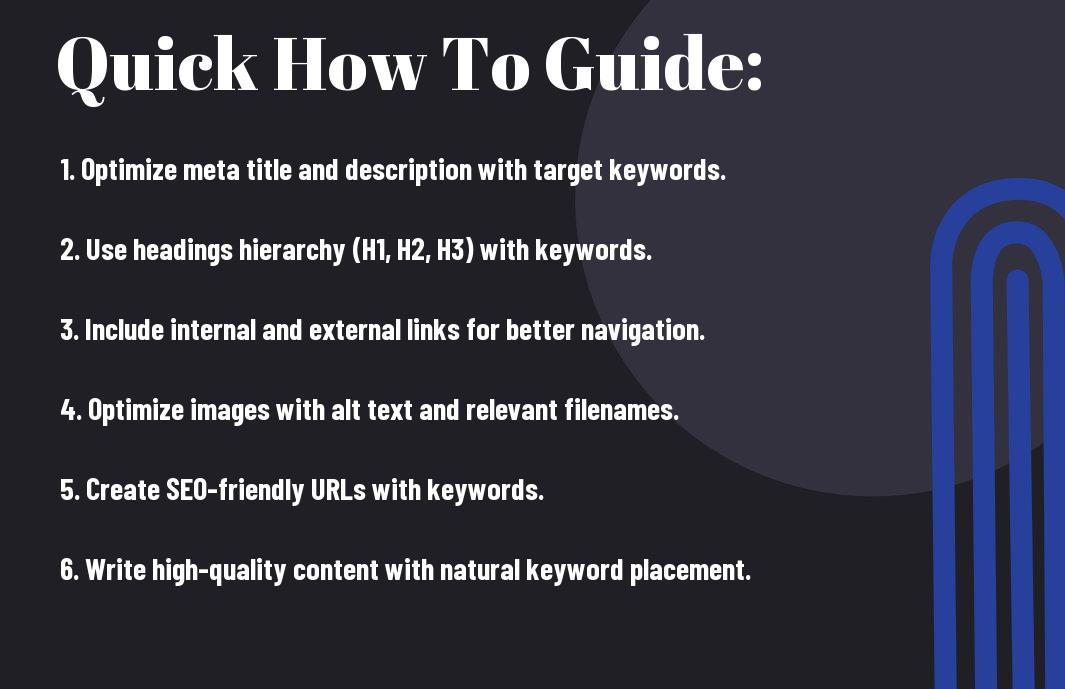Optimize your website for search engines by mastering the art of on page SEO. By focusing on elements like keywords, meta tags, URL structure, and content quality, you can improve your website’s visibility and ranking. In this guide, we will walk you through the steps to effectively implement on page SEO techniques on your website, ensuring that your content is easily discovered by search engines and users alike.
Understanding On-Page SEO
Definition and Importance of On-Page SEO
On-Page SEO refers to the optimization strategies you implement on your website pages to improve your search engine rankings and organic traffic. This includes various elements such as keyword optimization, content quality, meta tags, internal linking, and website structure. The importance of On-Page SEO cannot be understated as it directly impacts your site’s visibility and relevance to search engines like Google.
How On-Page SEO Differs from Off-Page SEO
Clearly understanding the difference between On-Page and Off-Page SEO is crucial for a successful digital marketing strategy. While On-Page SEO focuses on optimizing your website’s content and structure, Off-Page SEO is all about external factors like backlinks and social signals that influence your site’s authority and credibility in the eyes of search engines.
Differs: It’s important to remember that while Off-Page SEO helps to establish your website’s authority and credibility, On-Page SEO is crucial for ensuring that your site is technically optimized and provides a great user experience. Both components work hand in hand to improve your search engine rankings and drive organic traffic to your website.

Keyword Research and Planning
The Ultimate Guide to On-Page SEO in 2024 emphasizes the importance of keyword research and planning in your SEO strategy. It’s crucial to understand what your target audience is searching for and how they are searching for it in order to optimize your content effectively.
How to Conduct Keyword Research for On-Page SEO
While conducting keyword research for on-page SEO, start by using tools like Google Keyword Planner, SEMrush, or Ahrefs to identify relevant keywords with high search volume and low competition. Additionally, analyze your competitors’ keywords to gain insights into what is working in your industry. Once you have a list of potential keywords, prioritize them based on relevance to your content and search volume.
Tips for Creating a Keyword Strategy
You should create a keyword strategy that aligns with your content goals and target audience. Consider the user intent behind each keyword and how it fits into the buyer’s journey. Your strategy should also incorporate long-tail keywords, which are more specific and can attract highly targeted traffic to your site.
- Focus on creating content around a mix of short-tail and long-tail keywords
- Regularly monitor and adjust your keyword strategy based on performance and changes in search trends
Assume that your keyword strategy will evolve over time as you gather more data and insights from your SEO efforts.
Factors to Consider When Selecting Keywords
To ensure your selected keywords are effective, you should consider factors such as search volume, competition, and relevance to your content. High-volume keywords may attract more traffic, but they could also be more competitive. On the other hand, low-volume keywords may be easier to rank for but might not drive as much traffic.
- Focus on long-tail keywords that are highly relevant to your content and audience
- Consider the intent behind each keyword and how it aligns with your content
Assume that selecting the right keywords is crucial for the success of your on-page SEO efforts.
Plus
Tips for keyword research and planning are vital for optimizing your on-page SEO and improving your search rankings. By understanding your audience’s search behavior and creating a strategic keyword strategy, you can increase your visibility in search engine results and attract more organic traffic to your website.
Optimizing Title Tags
Not sure how to optimize your title tags for your website? Check out this comprehensive guide on On-Page SEO: What It Is and How to Do It for more in-depth information.
How to Write Effective Title Tags
Assuming you want your title tags to capture the attention of both users and search engines, there are a few key elements to keep in mind. Your title tags should be descriptive, concise, and include relevant keywords to improve your website’s visibility in search results.
Tips for Using Keywords in Title Tags
Now, let’s talk about how to effectively use keywords in your title tags. You should place your most important keywords near the beginning of the title tag to ensure they are seen by both users and search engines. Additionally, avoid keyword stuffing and focus on creating a title tag that accurately describes the content on your webpage.
- Avoid using too many keywords in your title tags
- Ensure your title tags are relevant to the content on the page
Title tags are an important part of on-page SEO, so it’s important to get them right. This small piece of text can have a big impact on your website’s visibility and click-through rates in search results.
Common Mistakes to Avoid When Writing Title Tags
Keywords play a crucial role in optimizing your title tags, but there are common mistakes you should avoid. For example, using generic titles that do not accurately reflect the content on your page can lead to a decrease in click-through rates and overall visibility in search results.
Mistakes in your title tags can negatively impact your website’s SEO performance. Be sure to review and update your title tags regularly to ensure they accurately represent the content on your webpage and include relevant keywords to improve your search visibility.
Crafting Meta Descriptions
The Role of Meta Descriptions in On-Page SEO
Now, let’s talk about the importance of meta descriptions in on-page SEO. Meta descriptions are HTML attributes that provide concise summaries of web pages. These descriptions show up on search engine results pages (SERPs) just below the page title and URL. While meta descriptions don’t directly impact search engine rankings, they play a crucial role in attracting users to click through to your website.
How to Write Compelling Meta Descriptions
For crafting compelling meta descriptions, you need to focus on creating descriptive and persuasive summaries of your webpage content. Your meta description should provide a clear idea of what the page is about and entice users to click on your link. Keep your meta descriptions under 160 characters to ensure they are fully displayed on search engine results.
The key is to incorporate relevant keywords that users might search for and highlight what makes your content unique or valuable. By including a call-to-action or posing a question, you can further engage users and increase the likelihood of them clicking through to your website.
Factors to Consider When Writing Meta Descriptions
- Ensure your meta descriptions accurately reflect the content of your webpage.
- Include relevant keywords to improve visibility and attract the right audience.
- Avoid duplicating meta descriptions across multiple pages to maintain uniqueness.
Even though meta descriptions don’t directly impact SEO rankings, they are still important for improving click-through rates and driving organic traffic to your website. After all, the goal is to not only rank high on search engines but also to compel users to click on your link when they see it in the search results.
Plus
Make sure to regularly review and update your meta descriptions to ensure they stay relevant and compelling to users. After all, search engine algorithms and user behaviors evolve over time, so it’s crucial to adapt your meta descriptions accordingly to maintain their effectiveness.
Header Tags and Structured Content
How to Use Header Tags to Organize Content
Organize your website content by utilizing header tags effectively. Header tags, such as H1, H2, H3, etc., help search engines understand the structure of your page. By using these tags, you can create a hierarchy of information on your page, making it easier for both users and search engines to navigate and comprehend the content.
Tips for Creating Structured Content
- Use header tags (H1 to H6) to organize your content hierarchy.
- Include relevant keywords in your header tags to improve SEO.
- Create a logical flow of information with subheadings to improve readability.
Recognizing the importance of structured content can enhance the user experience on your website and boost your search engine ranking. By following these tips, you can ensure that your content is well-organized and easy to digest for both users and search engines.
The Importance of Header Tags in On-Page SEO
On-page SEO plays a crucial role in helping search engines understand the relevance of your content. Header tags are an important part of on-page SEO as they provide a clear structure for your content. By using header tags correctly, you can indicate to search engines what the main topics of your page are, which can improve your chances of ranking higher in search results.
The proper use of header tags not only enhances the readability of your content but also signals to search engines the key topics of your page. By incorporating relevant keywords in your header tags, you can optimize your content for SEO and improve your website’s visibility online.
Content Creation and Optimization
Despite the many factors that go into search engine optimization, content remains king when it comes to ranking well in search results. Creating high-quality, engaging content that is optimized for keywords is necessary for driving organic traffic to your website.
How to Create High-Quality, Engaging Content
Engaging your audience is the key to creating content that resonates with them. To create high-quality, engaging content, you must first understand your target audience’s needs and interests. Conducting thorough research on trending topics, frequently asked questions, and industry news can help you identify content ideas that will captivate your audience. Once you have a topic in mind, focus on creating unique and valuable content that provides insightful information or solves a problem for your readers. Make sure to use a conversational tone and include visuals such as images or videos to enhance the readability of your content.
Tips for Optimizing Content for Keywords
- Include your target keyword in the title, headings, and meta description of your content.
- Use variations of your keyword throughout the content to improve its relevance to search engines.
- Optimize your images with descriptive file names and alt text containing your keywords.
HighQuality content that is optimized for keywords can help search engines understand the relevance of your content to user queries. By strategically placing your target keywords throughout your content, you can improve its visibility in search results and attract more organic traffic to your website. After creating your content, make sure to monitor its performance using analytics tools to identify areas for improvement.
Factors to Consider When Measuring Content Quality
A crucial aspect of content creation is measuring its quality to ensure it meets the needs of your audience and aligns with your SEO goals. Factors to consider when evaluating content quality include relevance, accuracy, uniqueness, credibility, and engagement. Assume that well-crafted content that addresses these factors is more likely to resonate with your audience and rank higher in search results.
- Assume that creating in-depth, comprehensive content that covers a topic thoroughly will help establish your website as a valuable resource in your industry.
Image Optimization
How to Optimize Images for Search Engines
While creating engaging visual content is imperative for your website, it’s important to remember that images also play a role in your SEO efforts. Search engines can’t “see” images, so it’s crucial to optimize them with relevant keywords and descriptive alt tags to improve your website’s visibility.
Tips for Using Alt Tags and Descriptions
For optimal on-page SEO, make sure to include descriptive alt tags and image descriptions for all the images on your website. Alt tags provide text descriptions of your images, which search engines can crawl to understand the content of the image. This can help improve your website’s overall SEO and make your content more accessible to all users, including those with visual impairments.
- Use relevant keywords in your alt tags and descriptions
- Keep your alt tags concise and descriptive
- Avoid keyword stuffing in your alt tags
Any images that are purely decorative and do not add value to your content can have empty alt attributes to ensure they are ignored by screen readers and search engines.
The Importance of Image Compression in On-Page SEO
Importance: In addition to optimizing image content, it’s also crucial to consider image file sizes. Large image files can slow down your website’s loading speed, which can negatively impact user experience and SEO rankings. By compressing your images without compromising quality, you can improve your website’s performance and SEO.
Understanding the impact of image compression on your website’s SEO can help you strike the right balance between high-quality visuals and fast loading times.
Internal Linking and Navigation
How to Create an Effective Internal Linking Strategy
Unlike external links that point to other websites, internal links are connections between pages within your own site. When done strategically, internal linking can improve your website’s SEO by spreading link equity and helping search engines understand the structure of your site. While creating an effective internal linking strategy, consider linking to relevant pages using descriptive anchor text. This not only helps users navigate your site but also provides search engines with valuable information about the content on each page.
Tips for Improving Website Navigation
Navigation is a critical aspect of user experience and plays a significant role in SEO. Ensuring easy navigation can help reduce bounce rates and increase the time users spend on your site, both of which are positive signals for search engines. Assume that users should be able to find what they are looking for within a few clicks. Organize your website’s menu structure logically and consider implementing breadcrumb navigation to help users understand their location within the site.
- Use clear and descriptive labels for navigation menus
- Include a search bar for easy access to specific content
Factors to Consider When Creating Anchor Text
With internal links, anchor text plays a crucial role in indicating the relevance of the linked page to both users and search engines. When creating anchor text, consider the context of the linked page and choose descriptive keywords that accurately represent the content users can expect to find. Recognizing the importance of anchor text in SEO can help you create a more effective internal linking strategy that enhances user experience and boosts your site’s visibility in search results.
- Avoid using generic anchor text like “click here” or “read more”
- Include keywords naturally within the anchor text for relevance

Mobile-Friendliness and Page Speed
How to Ensure a Mobile-Friendly Website
Many users access websites on their mobile devices, so it’s crucial to ensure that your website is mobile-friendly. An easy way to do this is by using responsive design, which automatically adjusts the layout of your site to fit different screen sizes. This ensures that your content is easily readable and accessible on all devices. Additionally, make sure to optimize your images and use mobile-friendly fonts to enhance the user experience on mobile devices.
Tips for Improving Page Speed
To enhance your website’s performance, focus on improving your page speed. One way to do this is by optimizing your images by compressing them without losing quality. Additionally, minify your CSS and JavaScript files to reduce loading times. Consider leveraging browser caching to store frequently accessed resources locally, further speeding up load times. The goal is to have your website load quickly and seamlessly for the best user experience.
- Optimize images by compressing them.
- Minify CSS and JavaScript files.
- Leverage browser caching to store resources locally.
The Importance of Mobile-Friendliness and Page Speed in On-Page SEO
MobileFriendliness and page speed are crucial factors in on-page SEO. Google considers mobile-friendliness as a ranking factor, so having a responsive website is vital for SEO success. Plus, page speed not only impacts user experience but also plays a role in search engine rankings. By focusing on these aspects, you can improve your website’s visibility and performance in search results.
Moreover, optimizing your website for mobile devices and ensuring fast page speed can help decrease bounce rates and increase user engagement. By prioritizing these factors, you are not only enhancing your SEO efforts but also providing a better overall experience for your website visitors.

Technical SEO Considerations
How to Optimize Website Architecture
Some of the key aspects to consider for optimizing your website’s architecture include creating a logical hierarchy of your pages, ensuring easy navigation for users, and organizing your content in a way that is easy for search engines to crawl. By structuring your website in a clear and organized manner, you can help search engines better understand the purpose of each page and how they relate to one another.
Tips for Improving Website Crawlability
Some simple tips for improving your website’s crawlability include creating an XML sitemap, using internal linking to connect related pages, and removing any duplicate or irrelevant content. By making it easier for search engine bots to navigate and index your site, you can ensure that your content is properly indexed and ranked in search results.
- Ensure your website is mobile-friendly
- Optimize your website’s loading speed
- Use descriptive URLs for your pages
Recognizing these factors and implementing them can have a significant impact on your website’s search engine visibility and overall performance.
Factors to Consider When Dealing with Duplicate Content
Understanding how to deal with duplicate content is crucial for maintaining a healthy SEO strategy. Factors to consider include using 301 redirects to canonical URLs, setting up proper URL parameters, and utilizing meta tags such as rel=canonical to indicate preferred versions of content. By addressing duplicate content issues proactively, you can avoid potential penalties from search engines and ensure that your website’s authority is not diluted.
- Regularly monitor your website for duplicate content
- Use tools like Google Search Console to identify duplicate content issues
After identifying duplicate content, take necessary steps to resolve them to improve your website’s SEO performance.
Local SEO Optimization
How to Optimize for Local Search
Even if you have a small business, it’s crucial to optimize your website for local search. This means ensuring that your website is optimized for local keywords and includes your business name, address, and phone number (NAP) on every page. Additionally, it’s crucial to include local schema markup to help search engines better understand your location and offerings.
Tips for Creating Content for Local Audiences
Even though you are optimizing for local search, it’s crucial to create quality content that resonates with your local audience. Make sure to include local references, events, and news in your content to make it more relevant to your target audience. Collaborating with local influencers and businesses can also help boost your local presence.
- Research local keywords and include them in your content
- Write blog posts about local events or news in your industry
- Include local testimonials and reviews on your website
Any digital marketing effort you put into your local SEO strategy should be reflected in the content you create for your website. By creating localized content, you can strengthen your connection with your local audience and improve your chances of ranking higher in local search results.
The Importance of Google My Business in On-Page SEO
Importance: One crucial aspect of local SEO optimization is setting up and optimizing your Google My Business listing. This free tool allows you to manage how your business appears on Google Search and Maps, making it easier for potential customers to find you. By including accurate information such as your business hours, contact details, and photos, you can improve your online visibility and credibility.
OnPage: By claiming and optimizing your Google My Business listing, you can boost your chances of appearing in local search results and attracting more local customers. Make sure to keep your listing up to date with any changes to your business information to maintain a strong online presence.
Content Freshness and Updates
How to Keep Content Fresh and Relevant
One of the key aspects of on-page SEO is keeping your content fresh and relevant. By regularly updating your content, you can attract more visitors and improve your search engine rankings. The following strategies can help you keep your content up-to-date:
Tips for Updating Existing Content
Updating your existing content is just as important as creating new content. It helps to ensure that your website remains current and provides value to your readers. Here are some tips for updating your existing content:
- Update statistics and data to keep information accurate and relevant.
- Refresh the content with new insights, examples, or case studies to add value.
- Optimize the content for relevant keywords to improve search engine visibility.
Any outdated information or broken links should be fixed during the update process to enhance user experience and credibility.
Factors to Consider When Measuring Content Freshness
Freshness of content is a crucial factor in determining its relevance to search engines. When evaluating your content freshness, consider the following factors:
- Knowing when the content was last updated can indicate its relevance to current trends.
For instance, if you have a blog post about ‘Top SEO Tips for 2018’ and it’s now 2021, updating the content with the latest strategies and trends will not only keep it fresh but also improve its visibility in search results.
Analytics and Tracking
How to Set Up and Use Google Analytics
With Google Analytics, you can track valuable information about your website’s performance, visitor behavior, and traffic sources. To set up Google Analytics, you need to create an account, add your website as a property, and install the tracking code on your site. Once set up, you can monitor key metrics such as page views, bounce rate, average session duration, and more to make informed decisions about your on-page SEO strategy.
Tips for Tracking On-Page SEO Metrics
- Monitor organic traffic to see how well your on-page SEO efforts are performing
- Track keyword rankings to identify which keywords are driving the most traffic to your site
Metrics such as click-through rates, conversion rates, and dwell time can provide insights into how engaging your content is and whether it is meeting the needs of your target audience. The data you gather from tracking these metrics can help you optimize your on-page SEO strategy for better results.
Factors to Consider When Analyzing On-Page SEO Data
- Knowing which pages have the highest bounce rates can help you identify areas for improvement
Analyzing on-page SEO data involves looking at a variety of factors such as traffic sources, user behavior, and conversion rates. By leveraging analytics tools and tracking software, you can gain valuable insights into how users are interacting with your website and make data-driven decisions to improve your on-page SEO performance.
Summing up
The key to successful on-page SEO is to ensure that your website’s content is optimized for search engines. This involves conducting keyword research, using relevant keywords in your titles, headings, and content, and creating high-quality, engaging content for your visitors. Additionally, you should pay attention to your website’s technical aspects, such as meta tags, image alt attributes, and internal linking structure. By following these strategies, you can improve your website’s visibility in search engine results and attract more organic traffic.

